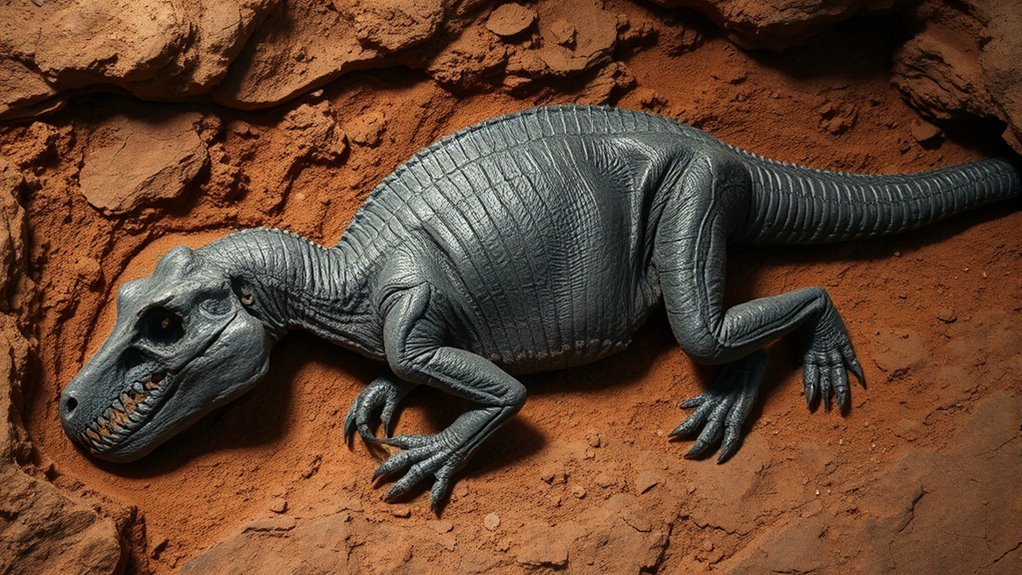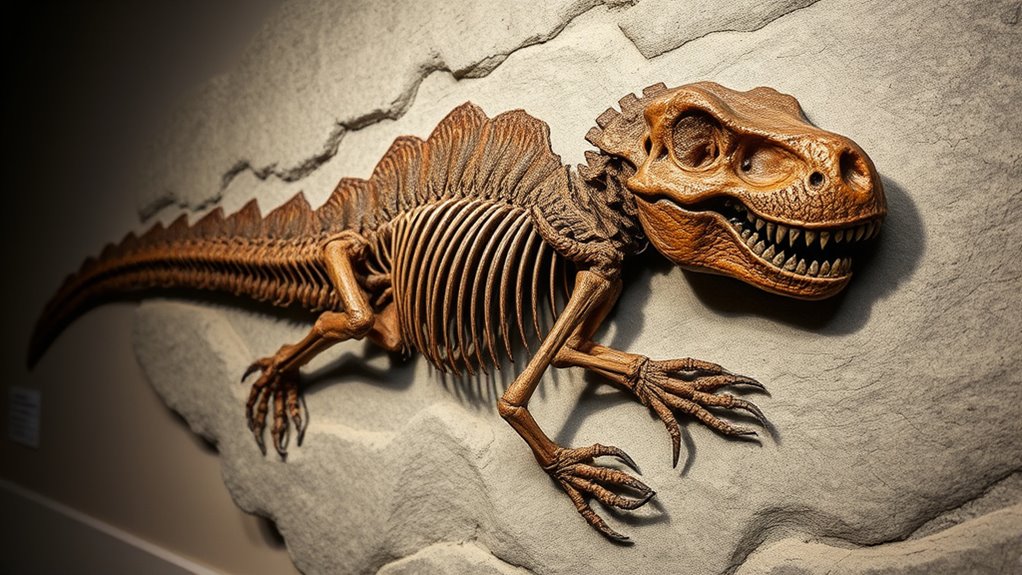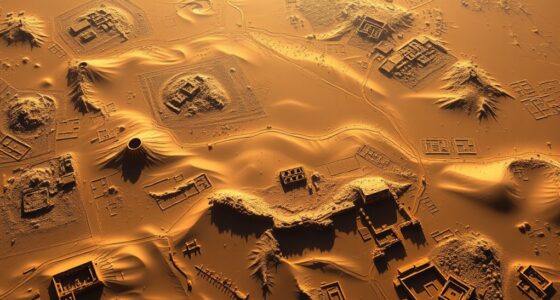Researchers have uncovered a rare dinosaur mummy with nearly fully preserved skin, providing extraordinary insights into dinosaur biology and soft tissues. This discovery reveals textures, potential coloration clues, and internal structures like muscles and organs that typically don’t fossilize. The preservation results from unique geological conditions, helping you understand more about ancient life and fossilization processes. If you keep exploring, you’ll uncover more fascinating details behind this exceptional find.
Key Takeaways
- The discovery features a dinosaur mummy with nearly complete skin preservation, offering rare insights into prehistoric skin textures.
- Soft tissues, including muscles and internal structures, remain intact, enabling detailed anatomical studies.
- Preservation resulted from rapid burial and mineralization, preventing decay over millions of years.
- This find enhances understanding of dinosaur biology, growth, and potential coloration clues from preserved skin.
- It provides valuable data for reconstructing ancient ecosystems and advancing paleontological research techniques.

Scientists have made a groundbreaking discovery by uncovering a rare dinosaur mummy, offering an unprecedented glimpse into the prehistoric creature’s preserved tissues and anatomy. This remarkable find highlights the exceptional quality of fossil preservation that can occur under specific environmental conditions. Unlike typical fossils that only reveal bones or fragmented remains, this mummy retains almost fully intact skin, muscle tissue, and some internal structures. Such preservation is extremely rare, making this discovery a treasure trove for paleontologists eager to understand the biology and physiology of dinosaurs in greater detail.
Rare dinosaur mummy reveals preserved tissues, offering new insights into prehistoric life and fossilization processes.
When you examine this mummy, you’ll notice how the skin has remained remarkably well-preserved, with textures and patterns that provide clues about the dinosaur’s appearance and potential coloration. The preservation of soft tissues allows scientists to analyze cellular structures, offering insights into the creature’s physiology that are usually lost in traditional fossilization processes. This level of detail is made possible through exceptional fossil preservation, where rapid burial and mineralization prevented decay and decomposition. It’s a testament to the unique geological conditions that can preserve organic materials over millions of years.
From a paleontological significance standpoint, this find is extraordinary. It opens new avenues for understanding the anatomy, growth patterns, and even possible diseases of dinosaurs. You might imagine how this mummy helps clarify debates about skin texture, muscle arrangement, and even potential feathers or scales. Such soft tissue preservation enhances our understanding far beyond what bones alone can reveal. It also gives researchers the chance to study the dinosaur’s internal organs, blood vessels, and other tissues, offering a more complete picture of prehistoric life.
This discovery underscores the importance of fossil preservation as a key factor in paleontological research. Every detail preserved contributes to reconstructing the environment, behavior, and evolutionary history of dinosaurs. The rarity of such soft tissue preservation amplifies the significance, making this find a pivotal moment in the field. It’s not just about uncovering bones; it’s about unraveling the story of life from millions of years ago with unprecedented clarity. As new techniques emerge, this mummy will continue to provide invaluable data, helping you and the scientific community better understand the ancient past and the forces that led to the preservation of such extraordinary remains.
Frequently Asked Questions
How Old Is the Dinosaur Mummy?
You might wonder how old this dinosaur mummy is. Using fossil dating, scientists estimate it’s around 66 to 100 million years old, placing it in the Late Cretaceous period. Preservation techniques helped keep its skin almost fully intact, providing rare insight into its biology. This incredible find offers a window into the past, revealing details that typical fossils often lack, making it one of the most significant discoveries of its kind.
What Species Is the Dinosaur?
You might wonder what species this remarkable dinosaur is. Based on the fossilization process and detailed analysis, scientists identify it as a theropod, closely related to birds. Its unique features help classify it within dinosaur taxonomy, revealing insights into its evolutionary history. This discovery not only highlights the preservation of skin but also offers clues about its ecological role, making it a significant find in paleontology.
How Was the Mummy Preserved so Well?
You might wonder how the mummy was preserved so well. It all comes down to the fossilization process and preservation conditions. Rapid burial in fine sediments limited decay, while low oxygen levels slowed decomposition. Mineral-rich water then replaced organic tissues, creating a detailed, almost intact fossil. These ideal conditions prevented bacteria from breaking down the remains, allowing the skin and soft tissues to be preserved remarkably well over millions of years.
Are There Other Similar Mummies Found?
You might wonder if other similar mummies have been found. While rare, some exceptional fossils have preserved soft tissues, offering valuable insights. These discoveries result from unique fossilization processes that prevent decay. Such mummies hold great paleontological significance, as they reveal details about ancient life that bones alone can’t show. Although uncommon, these finds deepen our understanding of prehistoric creatures and their environments.
Can This Discovery Help Understand Dinosaur Behavior?
This discovery can substantially enhance your understanding of the fossilization process and dinosaur social behavior. By examining the preserved skin and tissue, you gain insights into how dinosaurs interacted and lived. The detailed preservation allows you to study their physical features and possible social structures more closely. Ultimately, this find helps you piece together behavior patterns, shedding light on how dinosaurs might have communicated or maintained social bonds during their lifetime.
Conclusion
This discovery reminds you that every so often, nature reveals its secrets in the most astonishing ways. As the saying goes, “A picture is worth a thousand words,” and this dinosaur mummy offers an incredible glimpse into the past. By studying these rare finds, you gain a deeper understanding of ancient life. Keep in mind that patience and curiosity often lead to the most extraordinary discoveries, proving that sometimes, the best things come to those who wait.









